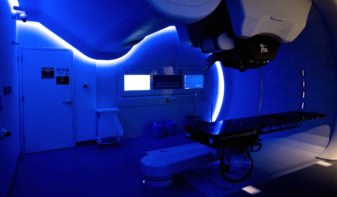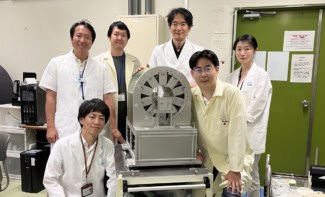
The annual congress of the European Society for Radiation Oncology (ESTRO) sees physicists, clinicians, radiobiologists and radiation therapists come together to share their latest research developments, technical innovations and clinical studies. The best abstract submitted each year, selected by the scientific programme committee, is chosen to receive the Donal Hollywood Award.
At the ESTRO 2021 meeting – a hybrid meeting held online and live in Madrid, Spain – the winner was Brita Singers Sørensen from Aarhus University Hospital in Denmark, for her study on pencil-beam scanning proton FLASH.
FLASH radiotherapy delivers radiation at ultrahigh dose rates of 40 Gy/s or more, with treatments taking less than 0.5 s. Preclinical studies indicate that FLASH offers remarkable normal-tissue sparing without impacting tumour control. But according to Sørensen, there’s still a lot of information lacking.
“For example, we are still missing data on proton pencil-beam scanning and on normal tissue damage from full dose–response curves,” Sørensen explained. “We also need data from tumour control studies and finally there’s a huge need to understand the underlying mechanism for FLASH.” As such, she is working with her team in Aarhus to tackle some of these outstanding problems.
To investigate the effect of proton FLASH delivered with a scanning pencil beam, Sørensen, physicist Per Poulsen, and their colleagues designed an experiment to irradiate a mouse hind leg with protons at either conventional or FLASH dose rates. They placed the animal’s leg in a water bath, in the beam’s entrance plateau (to perform transmission FLASH rather than treating with the Bragg peak) and measured the delivered dose using an alanine pellet at the beam entrance and a scintillating crystal behind the target.
The researchers irradiated 154 mice with 244 MeV protons at a conventional dose rate (0.4 Gy/s), with doses ranging from 24.6 to 41.6 Gy. They also treated 144 mice with 250 MeV protons at a FLASH dose rate of 69–90 Gy/s. Here, they studied 12 dose levels of between 32.4 and 55.6 Gy. Mice in each dose group were scored daily for acute skin toxicity, from day 11 to day 28. The team then calculated the percentage of mice with a certain toxicity score in each dose group.
Comparing dose–response curves at five skin damage levels revealed a FLASH sparing factor of between 1.41 and 1.55. “The conclusion so far is that with pencil-beam scanning proton FLASH, we do see a normal tissue sparing effect on acute skin damage; we see 40 to 50% sparing,” said Sørensen.
But normal tissue damage is only half of the story when it comes to FLASH – the other half is investigating the impact on the tumour. With this aim, the team is currently conducting a parallel study looking at tumour control with proton FLASH, using the same set-up to irradiate mice with tumours implanted their hind legs.
Sørensen added that there are many other important factors to consider, such as investigating intermediate dose rates and the effect of beam pauses and fractionation. “Finally, we would very much like to look at FLASH in a spread-out Bragg peak instead of using a transmission beam as this would increase the clinical relevance,” she told the ESTRO delegates.
The award finalists
The four finalists for the Donal Hollywood Award presented their studies in a dedicated conference session. The three other finalists were:
- Marie Louise Milo from Aarhus University. Milo presented a study investigating the risk of radiation-associated heart disease following radiotherapy for early-stage breast cancer. In a cohort of over 15,000 patients treated with CT-based radiotherapy, 204 were identified as having coronary artery disease following irradiation. Milo assessed the individual doses to the heart and cardiac substructures in these patients, as well as in matched controls from the cohort. The mean heart dose was 1.6 Gy in left-sided and 0.8 Gy in right-side irradiated patients, with the highest doses seen in different substructures for the two groups. But despite these differences in dose distribution, no difference was seen in the distribution of coronary artery disease. Milo also noted that no differences in the mean heart dose were seen between the heart disease cases and the controls. She concluded that, at a median follow up of 7.3 years, there was no dose–response relationship between the radiation dose and coronary artery disease.
- Erica Bennett from Bon Secours Radiotherapy Cork. Bennett described her experience of implementing an oncology prehabilitation programme during the COVID-19 pandemic. Prehabilitation, she explained, occurs between a patient’s cancer diagnosis and their treatment. The process includes baseline physical and psychological assessments, and provides interventions to improve health and reduce the incidence of future impairments. Bennett designed a seven-week pilot programme incorporating exercise, diet and psychological support, with a combination of online and in-person interventions. The programme aimed to prepare patients for their treatment, educate them on physical health and wellbeing, and provide tools and support for lifestyle changes. All six patients enrolled in the pilot found the programme valuable and would recommend it to others. Bennett concluded that while the need for online counselling was not ideal, it was still possible to implement a successful prehabilitation programme during the pandemic.
- Tobias Gauer from University Medical Center Hamburg. Gauer shared his findings on how 4D-CT imaging affects the outcome of stereotactic body-radiotherapy (SBRT) for lung and liver metastases. SBRT treatments are planned based on 4D-CT scans, but the reconstructed data often contain artefacts due to suboptimal imaging protocols or irregular patient breathing. A study of 373 SBRT cases revealed that while the mean breathing period was mostly predictable, breathing amplitude was random. Conventional 4D-CT can’t compensate for this unpredictability, resulting in artefacts. To assess the correlation between artefacts and clinical outcome, Gauer categorized 4D-CT planning data from 62 patients with 102 metastases as having severe or no/moderate artefacts. He found that local metastasis control was reduced from 90% to 70% if the SBRT planning data contained severe artefacts. He concluded that artefact-affected SBRT planning data impact the entire radiotherapy process and will likely influence clinical outcome. Such CT-related limitations could be overcome by employing breathing-adjusted imaging protocols.



